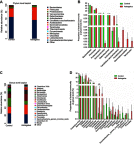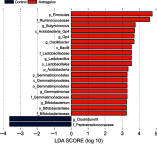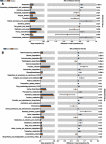Astragalus alters gut-microbiota composition in type 2 diabetes mice: clues to its pharmacology
- PMID: 31190935
- PMCID: PMC6529725
- DOI: 10.2147/DMSO.S203239
Astragalus alters gut-microbiota composition in type 2 diabetes mice: clues to its pharmacology
Abstract
Background: Astragalus possesses therapeutic effects for type 2 diabetes (T2D), while its action mechanisms remain to be elucidated. In view of the pathogenic associations between gut microbiota and T2D, we explored the effect of astragalus on gut-microbiota composition of T2D mice. Materials and methods: Modulation effects of astragalus on gut microbiota of T2D-model mice were assessed by 16S rRNA gene sequencing. Results: Inhibited blood-glucose and body-weight levels of T2D mice by astragalus were accompanied by gut microbiota-composition alteration. Astragalus administration significantly increased gut-microbiota richness and diversity in T2D mice and significantly altered the abundance of several bacterial taxa, inducing increased abundance of Lactobacillus and Bifidobacterium. PICRUSt software revealed the relationship between astragalus and T2D. Conclusion: Due to previously reported decreased gut-microbiota richness and diversity and reduced abundance of key species of Lactobacillus and Bifidobacterium, more studies are encouraged to explore the contribution of gut-microbiota alteration by astragalus to its anti-T2D effect.
Keywords: 16S rRNA gene sequencing; alteration; astragalus; gut microbiota; type 2 diabetes.
Conflict of interest statement
The authors report no conflicts of interest in this work.
Figures





Similar articles
-
Effects of single-anastomosis duodenal-ileal bypass with sleeve gastrectomy on gut microbiota and glucose metabolism in rats with type 2 diabetes.Front Microbiol. 2024 May 27;15:1357749. doi: 10.3389/fmicb.2024.1357749. eCollection 2024. Front Microbiol. 2024. PMID: 38863754 Free PMC article.
-
Exploring the gut microbiota in patients with pre-diabetes and treatment naïve diabetes type 2 - a pilot study.BMC Endocr Disord. 2023 Aug 21;23(1):179. doi: 10.1186/s12902-023-01432-0. BMC Endocr Disord. 2023. PMID: 37605183 Free PMC article.
-
Modulation effects of Dendrobium officinale on gut microbiota of type 2 diabetes model mice.FEMS Microbiol Lett. 2021 Apr 8;368(5):fnab020. doi: 10.1093/femsle/fnab020. FEMS Microbiol Lett. 2021. PMID: 33606020
-
Effects of Non-insulin Anti-hyperglycemic Agents on Gut Microbiota: A Systematic Review on Human and Animal Studies.Front Endocrinol (Lausanne). 2020 Sep 23;11:573891. doi: 10.3389/fendo.2020.573891. eCollection 2020. Front Endocrinol (Lausanne). 2020. PMID: 33071980 Free PMC article.
-
The role of gut microbiota in the development of type 1, type 2 diabetes mellitus and obesity.Rev Endocr Metab Disord. 2015 Mar;16(1):55-65. doi: 10.1007/s11154-015-9309-0. Rev Endocr Metab Disord. 2015. PMID: 25619480 Free PMC article. Review.
Cited by
-
Characteristics of Gastric Microbiota in GK Rats with Spontaneous Diabetes: A Comparative Study.Diabetes Metab Syndr Obes. 2020 Apr 30;13:1435-1447. doi: 10.2147/DMSO.S242698. eCollection 2020. Diabetes Metab Syndr Obes. 2020. PMID: 32431527 Free PMC article.
-
Danggui Buxue decoction regulates the immune function and intestinal microbiota of cyclophosphamide induced immunosuppressed mice.Front Pharmacol. 2024 Aug 19;15:1420411. doi: 10.3389/fphar.2024.1420411. eCollection 2024. Front Pharmacol. 2024. PMID: 39224776 Free PMC article.
-
Medicinal Plants and Their Impact on the Gut Microbiome in Mental Health: A Systematic Review.Nutrients. 2022 May 18;14(10):2111. doi: 10.3390/nu14102111. Nutrients. 2022. PMID: 35631252 Free PMC article.
-
Irritable Bowel Syndrome and Depression: A Case Report.Integr Med (Encinitas). 2021 Oct;20(5):38-43. Integr Med (Encinitas). 2021. PMID: 34803539 Free PMC article.
-
Effects of compound small peptides of Chinese medicine on intestinal immunity and cecal intestinal flora in CTX immunosuppressed mice.Front Microbiol. 2022 Jul 25;13:959726. doi: 10.3389/fmicb.2022.959726. eCollection 2022. Front Microbiol. 2022. PMID: 35958151 Free PMC article.
References
-
- International Diabetes Federation. IDF Diabetes Atlas. 8th ed. Brussels: IDF; 2017.
-
- Beckman JA, Creager MA, Libby P. Diabetes and atherosclerosis: epidemiology, pathophysiology, and management. JAMA. 2002;287:2570–2581. - PubMed
LinkOut - more resources
Full Text Sources

